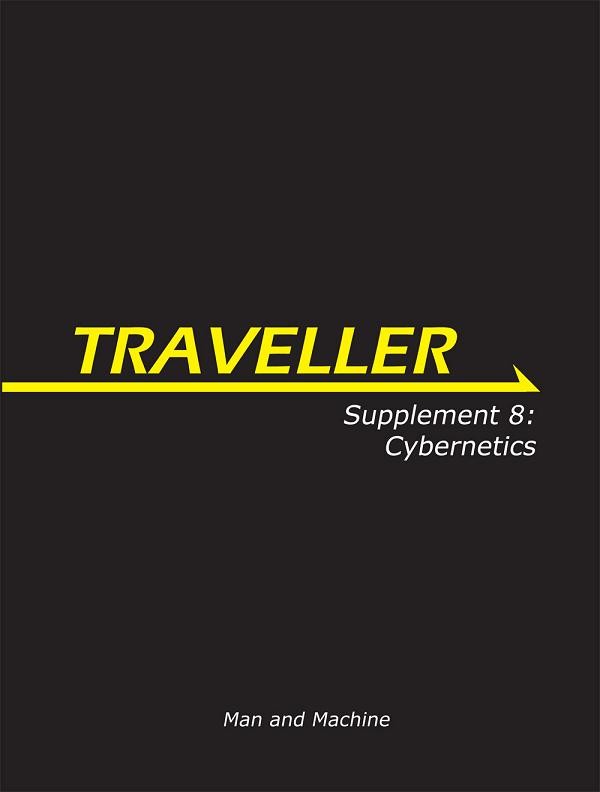Mongoose Traveller Supplement 8: Cybernetics
This review originally appeared on rpg-resource.org.uk in July 2015, and was reprinted in the March/April 2016 issue.
 Mongoose
Traveller Supplement 8: Cybernetics. Lawrence Whitaker.
Mongoose
Traveller Supplement 8: Cybernetics. Lawrence Whitaker.
Mongoose Publishing http://www.mongoosepublishing.com
98pp, softcover
US$24.99/UKú16.99
This is an exciting new move for Traveller, the addition of ‘cyberpunk’-style augmentation to the human (or indeed alien) body. Eminently sensible, too, it is likely that such modifications will be possible by the far future.
The Introduction looks at how the concept has changed over the years, with some of what early cyberpunk authors (in fiction as well as in games) imagined has been modified or even superseded by real-world developments (compare the modern World Wide Web with William Gibson’s ideas about computer networks and hacking [or, as he called it, ‘decking’]… I still treasure an autographed copy of one of his books addressing me as a ‘fellow decker’!), whilst other things imagined have yet to come to pass. The intention with this book, however, is to re-create some of the 1980s cyberpunk feel, especially in the rules and ideas presented for computing and cyberspace, and to enable some of the wilder comic-book concepts regarding cybernetic enhancement and augmention. So the book comes in two parts: cybernetics and cyberspace, and it is up to individual referees to decide which (if any) of the material herein applies in their universe.
First up, Character Creation. This is aimed primarily at those who want their characters to already have cybernetic augmentations perhaps from an early stage in their pre-game career. So it presents a number of careers and options based on a character having cybernetic parts from the outset (or installed as he starts out in his chosen career, anyway) so that by the time he is ready for play the cybernetics really are a part of him. There’s everything from super spies to ultimate fighting machines, but also more ‘ordinary’ characters who may have grown up in a society where cybernetics are the norm and even office workers have augmentations… and a wholly new career of ‘cybenet’, those who live and breathe the online life. The noble options are quite fun too, and even psions get a look-in.
OK, so vague table entries about enhancement are not enough. The next section, Before the Chrome, addresses that, beginning with a definition of cybernetics as the interface between organic systems and synthetic ones, anything from an artificial limb to full-blown cyborgs, enhancements and augmentations. There are four reasons why a character might have such cybernetics: because they're fashionable, through medical necessity, to serve the needs of a particular task or job, or because he lives in a society where cybernetics are all-pervasive and everybody has them. Such societies are unusual, and unlikely to be found lower that Tech Level 13; but they could be interesting places to visit! However, from TL 8 or so you can get like-for-like cybernetics, say a hand that works almost as well as your meat one did, but from TL 10 and above you will find spare parts that work better than whatever they replace. At TL 13 it is possible to transplant a living brain into a completely artificial body. There’s plenty detail here about what you can get, how it’s installed and how the Tech Level affects the quality and performance of your new parts. It also talks about traumatic needs—Traveller damage is normally expressed in terms of your Strength, Dexterity and Endurance rather than in actual damage to specific parts of the anatomy—and the disadvantages as well as the advantages of replacing part of your body.
This section ends with a brief note about biotechnology as opposed to mechanical spare parts, and then we move on to chapters looking at specific areas of the body and what you can get: limbs, body and head augmentations, a section on Chrome, Chips and Plug-Ins, and finally weapons. If you cannot find what you need here, your imagination is working overtime… in each case, the biotech equivalent is mentioned although the main focus is mechanical. It’s very human-centric, so if your Vargr has lost his tail there isn’t a specific spare part for him although it should be straightforward to work from the examples to come up with what he needs.
The second, and smaller, part of the book deals with Cyberspace. The significant difference between this and regular computing as you and I know it today is that it provides ways to visualise what is going on out there between your computer and the website or data store that you are accessing. This creates an interactive environment which can, of course, be manipulated… for good or evil depends in the main on your point of view. If you enjoy the ‘netrunning’ of the cyberpunk genre (for example as done in Cyberpunk, CyberSpace or Shadowrun) then this will be for you. If you are happier with more realistic hacking you may still find some of the mechanics useful even if you eschew the imagery.
The final section, Patrons, provides a number of potential patrons who can offer a party employment that in some way involves cybernetics. They all come in standard patron encounter format complete with six possible outcomes/twists, roll a D6 or pick whatever takes your fancy. Ideal if you need a quick adventure idea and several do not require the characters themselves to be ‘cybered-up’ to take the job… so you could even use them as a prelude to introducing material from this book into your game.
Cybernetics isn’t for everyone, but if you like the idea it’s one way to make your Traveller universe a lot more than ordinary people who happen to have access to FTL starships! Certainly worth a look…
 Freelance
Traveller
Freelance
Traveller